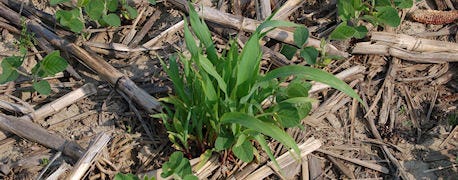
Bill Johnson's phone still rings quite frequently this time of year with calls about how to kill volunteer corn in soybeans. Usually the farmer planted Roundup Ready corn the year before. An application of glyphosate that will get other weeds won't bring down the volunteer corn.
Johnson is a Purdue University weed control specialist. He says the products of choice for bringing down volunteer corn in soybeans are two different chemistries with the brand names of Select Max and Assure. You might also consider Fusion or Fusilade.

Good start- This clump of volunteer corn could still be controlled with lower rates. Once it gets bigger, more product per acre is needed for control.
The rate for each product varies, and is spelled out on the label, he notes. For the most part the labeled rate for the product to control volunteer corn in soybeans depends upon the size of the corn. For example, for Select Max, the label says 6 ounces of Select Max per acre for volunteer corn up to 12 inches tall, and 9 ounces per acre for corn 12-inches to 24-inchesw tall.
For Assure the label says you can apply 4 ounces per acre on volunteer corn in soybeans if the volunteer corn is up to 12 inches tall. If it is 12 to 18 inches tall, bump the rate up to 5 ounces of Assure per acre. If the volunteer corn in soybeans is 18 to 30 inches tall, go with 8 ounces of Assure per acre. If the corn is relatively thick, you're going to lost yield of soybeans to weed competition if you let it get that big. Volunteer corn in soybeans acts like a weed.
Rates are similar for both Fusion and Fusilade. Use 4 ounces per acre on corn up to 12 inches tall in soybeans, and use 6 pounces per acre of Fusion or Fusilade to control volunteer corn in soybeans if the volunteer corn is more than 12 inches tall.
Some products that are good on grasses in soybeans are not as effective on volunteer corn. For example, Poast does a good job on annual grasses but it not as effective on volunteer corn.
If the corn planted last year was non-GMO, you can control it with regular soybean postemergence grass herbicides, including glyphosate. This will also control Liberty Link corn. If the last corn crop was Liberty Link corn, Liberty won't control the volunteer corn that might be in the field.
About the Author(s)
You May Also Like




